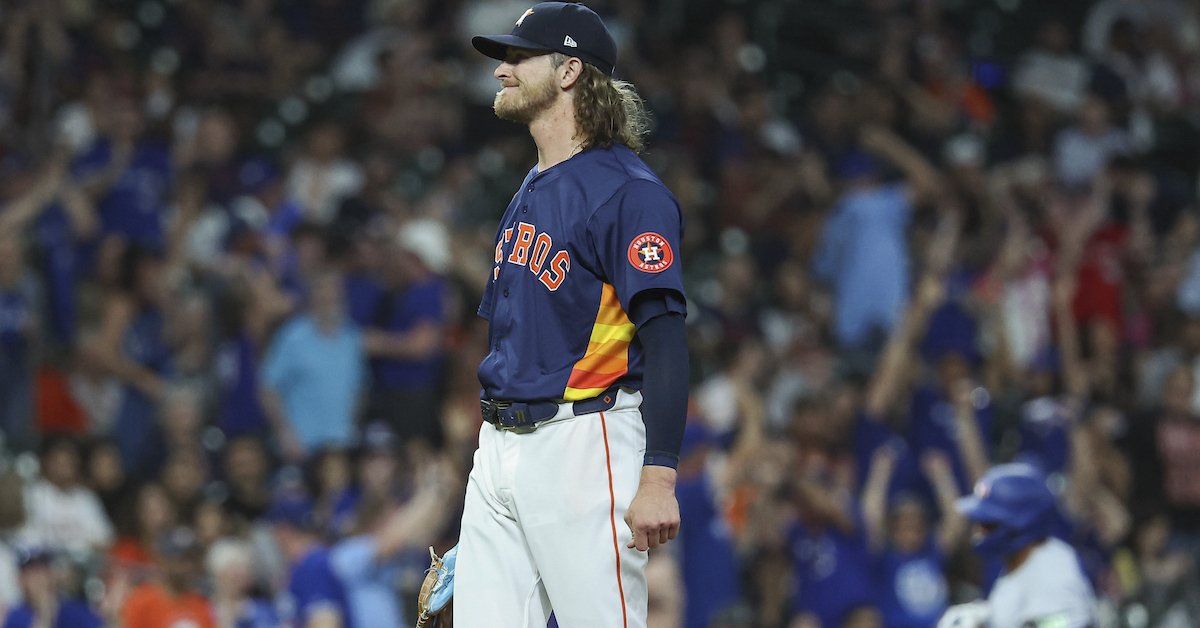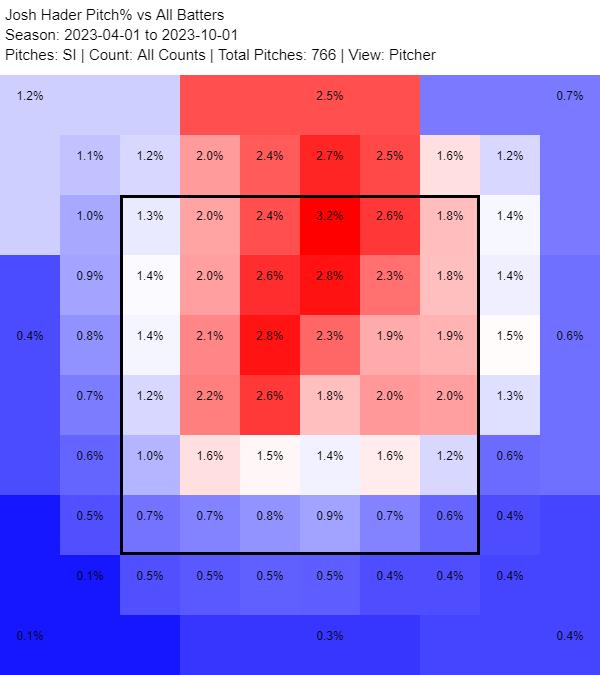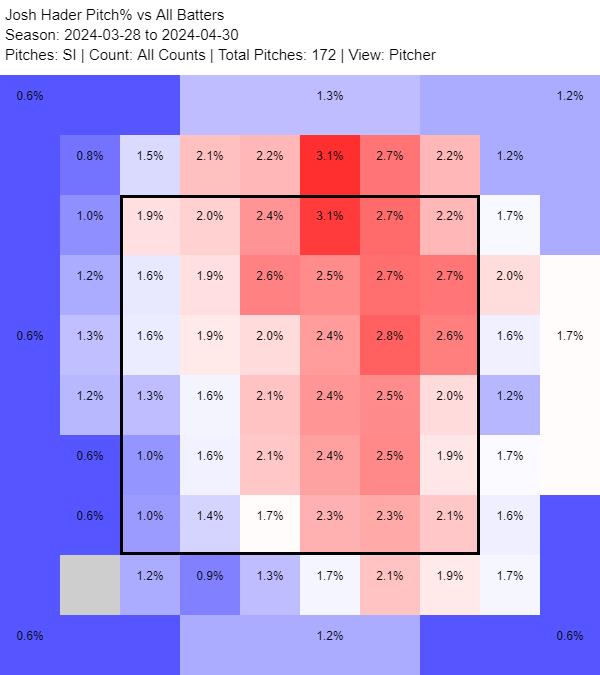
Troy Taormina-USA TODAY Sports
If you’re going to spend big on a free agent closer, you should probably shop at the top of the market. That’s what the Astros did this past offseason, shelling out $95 million over five years to bring Josh Hader home. Last season, Hader was unhittable, with a 1.28 ERA in 61 appearances and 33 saves in 38 opportunities.
This year, not so much. His ERA is 6.39, and was over 9.00 on Tax Day. He’s only had two saves, which is partially his teammates’ fault, but Hader has also blown a save and taken a loss. The Astros, meanwhile, have struggled to find spots to use him. He’s had only one save opportunity since the first week of April, including a weeklong stretch in which he didn’t pitch at all. Tuesday night, Hader had his first two-inning regular-season relief appearance since 2019. Not the start either Hader or the Astros envisioned, I think we can all agree.
When a reliever starts a multi-year contract like this — particularly a reliever in his 30s, who had some highly publicized struggles in the past 24 months — panic sets in really quickly. But with Hader, there’s considerable evidence that his ineffectiveness is mostly the result of being swallowed by the Astros’ Charybdis of rottenness so far this season, rather than a sudden loss of effectiveness.
Hader is running a higher strikeout rate than last year, with a lower walk rate. His BABIP is .444, which is unsustainable for a human pitcher (as opposed to a tee) and the discrepancy between Hader’s ERA and FIP (more than four runs) is the ninth highest among more than 200 qualified relievers.
Moreover, Hader has suffered from some bad sequencing. His LOB% is only 51.1% (it was 88.8% last year), and if you eliminate a four-run, 1/3-inning outing against the Braves, Hader’s ERA would be 3.64. I know it doesn’t work that way, and 3.64 is not what he’s getting paid $19 million a year to produce, but if Hader’s ERA were in the mid-3.00s at the end of April, nobody outside of Harris County would’ve noticed.
The season is still young enough that it’s not any real inconvenience to go back and watch every single base hit Hader’s given up. Of the 13 hits he’s allowed, 10 were singles, which tells you something right off the proverbial bat. One of the three extra-base hits, a triple in the gap by CJ Abrams, hung up in the air for an eternity and would’ve been an easy out if it were hit a few degrees in either direction. That same inning, Lane Thomas got credit for an infield single that should’ve been an error on Jose Altuve, and there’s the Gleyber Torres blooper that came off the bat at 59.3 mph. That’s how you run up a .444 BABIP.
I’d love to be able to write this off as early season variance. God knows my job would be easier if, every time something weird happened in April, I could throw my hands up and say, “Small sample size!” But a few of those hits raised red flags. For example: There was a ringing single by Brenton Doyle — giving up any hard contact to Doyle is worrisome — and a conga line of scalding line drives in that one nightmare outing against Atlanta.
I want to highlight two things Hader is actually doing differently this season compared to previous years, because as much as I think his ugly ERA is mostly the result of some bad sequencing and the wrath of the BABIP gods, I’m concerned by how he’s throwing his slider and where he’s throwing his fastball.
Let’s go back to that list of Hader’s hits. Only three of the 12 were off the slider. One was a pretty well-located backdoor breaking ball that Ronald Acuña Jr. smashed back through the box (almost through Hader’s ankles, in fact) for a single. Not to worry — pitch in this league long enough and eventually you’re going to get Charlie Browned by Acuña.
One of the other two hits Hader surrendered off his slider was his only home run of the year. Davis Schneider came to the plate down a run with a man on first and two outs in the ninth and did this.
One thing I like about Minute Maid Park is that big line of Astros Community Sponsors partner signs behind the Crawford Boxes. (Including the only Halliburton ad I can remember seeing in person.) When a home run hits one of those huge metal placards it makes a satisfying BONG. If you watch the video of Schneider’s home run you can hear that low, resonant thud behind Todd Kalas’ commentary.
This home run was part of Schneider’s clutch folk hero narrative that happened a few weeks ago, but the truth is this pitch was an absolute meatball. Any competent big league hitter would’ve kabonged this cement mixer slider off the Halliburton sign. And Hader knew it — before the director could even change camera angles, the Astros’ closer had already begun to drop into a squat that should be familiar to every pitcher who gives up a big home run.
On one hand, hanging a slider and blowing a save is a huge deal, even in April. But at the same time, it happens, even to good closers. I’m not going to draw sweeping conclusions about Hader based on the result of a few dozen sliders, but overall, Hader’s slider is more or less as effective as it was last year. The mistake to Schneider was ugly, and impactful, but it looks like an isolated event.
Nevertheless, I’m concerned about one thing: For most of his career, Hader was throwing his slider in the low 80s on average. That velo crept up into the mid-80s over the past three seasons, but so far in 2024, Hader’s slider is averaging 87.5 mph. That’s not a problem in isolation — again, the pipe shot to Schneider notwithstanding, Hader’s slider has been fine this year.
But opponents are hitting .344 off his fastball. Some of that is probably BABIP; his opponent xBA is .197, and that elevated batting average amounts to 10 hits over 17 batted ball events, which is going to come back to Earth eventually. But Hader’s whiff rate on his sinker is the lowest of his career.
Most important, there is a change you can point to.
For most of his career, and especially after he made the transition to a traditional one-inning closer role, Hader has lived up the zone with his fastball. Even though the fastball gets tagged as a sinker and we think of the sinker as being a keep-it-off-the-barrel pitch that gets used to induce groundballs, Hader has had his greatest success using it to miss bats up in the zone. Here’s where he was throwing the heater last year.

Hader wasn’t really filling up the strike zone with fastballs; he was pounding the very top of the zone. Hader debuted in 2017, and from that year through 2023, he was one of 277 pitchers who threw at least 300 innings in the major leagues. Of those 277 pitchers, Hader had the third-highest IFFB%, the second-lowest contact rate, the second-lowest ERA, the highest K%, and the lowest (by almost 20 points) opponent batting average.
Hader’s traditional approach is arguably the most effective strategy employed by any pitcher in the majors in the past seven years. It generated the two most desirable outcomes — whiffs and popups — with alarming frequency. And now he’s just… not really doing that. Here’s the heat map of Hader’s sinker from this season.

Hader is now pitching the way most people organize their refrigerator: Cheese goes on the bottom drawer.
For the first seven seasons of his career, Hader was as extreme a fly ball pitcher as you’ll find. His career fly ball rate entering this season was the sixth highest out of that 277-pitcher sample. This year, his groundball rate is 55.6%, probably because he’s throwing more fastballs down in the zone. (“Low” in the following table is defined as the bottom four inches of the strike zone and below.)
Hader on the Ground
| Year |
GB% |
Low FB% |
Low SL% |
FB Velo |
SL Velo |
Velo Diff. |
| 2017 |
34.4 |
15.9 |
40.2 |
94.3 |
80.3 |
14.0 |
| 2018 |
28.9 |
15.4 |
52.4 |
94.5 |
81.9 |
12.6 |
| 2019 |
22.0 |
6.7 |
50.0 |
95.5 |
81.9 |
13.6 |
| 2020 |
26.5 |
2.4 |
50.0 |
94.5 |
80.3 |
14.2 |
| 2021 |
30.5 |
7.8 |
53.7 |
96.4 |
83.6 |
12.8 |
| 2022 |
29.2 |
10.8 |
55.8 |
97.4 |
84.0 |
13.4 |
| 2023 |
35.5 |
7.3 |
55.0 |
96.1 |
85.7 |
10.4 |
| 2024 |
55.6 |
15.7 |
59.4 |
95.9 |
87.5 |
8.4 |
SOURCE: Baseball Savant
For a relief pitcher, more grounders theoretically mean more double play balls; Hader’s already induced two this season in just 12 games, halfway to his career high of four. But that also means a lot of hard contact on the ground, and a lot of those hard-hit singles like the ones the Braves strung together.
Insofar as Hader’s struggles early this season have been more than a small-sample mirage, here’s my theory: Hader is throwing more sinkers down in the zone, which in addition to flying in the face of everything we learned from the rapid collapse of the early-2010s Pittsburgh Pirates two-seamer factory, puts that pitch in the same location as where he traditionally throws his slider.
At the same time, the velocity gap between Hader’s fastball and slider — which had held at around 12 to 14 mph for most of his career — is into the single digits.
The most basic, stereotypical characteristic of the relief ace — more than bad facial hair, twitchy mound presence, or heavy metal entrance music — is the hard fastball up in the zone accompanied by a sharp breaking ball low. Get enough heat on the fastball and enough spin on the breaker, and no hitter alive is going to be able to cover both.
Now, Hader is throwing his fastball and his slider in the same place, and there’s so little velocity difference between the two that a hitter can be late on the fastball or early on the slider, guess wrong, and still square the pitch up.
Watching Hader last night, he also got hosed on two low sinkers that got called balls despite being in the zone; one of them got enough of the zone it didn’t even show up in my search.
Home plate ump Stu Scheurwater is usually pretty solid, but it’s like he knew I was writing about this and wanted to dissuade Hader from throwing his fastball there.
I’m not necessarily worried about Hader long-term because there’s no reason he can’t just go back to doing what he was doing last year. Indeed, he pitched up in the zone with his fastball more last night than in any previous outing this year, and came out of the game with four strikeouts and a win. He’d be wise to continue pitching this way; those who deviate from the path of success only tempt the wrath of the BABIP gods.
Source
https://blogs.fangraphs.com/is-josh-hader-cursed-broken-or-both/
 Backyard GrillingWeekend WarriorsAdvice from DadBeard GroomingTV Shows for Guys4x4 Off-Road CarsMens FashionSports NewsAncient Archeology World NewsPrivacy PolicyTerms And Conditions
Backyard GrillingWeekend WarriorsAdvice from DadBeard GroomingTV Shows for Guys4x4 Off-Road CarsMens FashionSports NewsAncient Archeology World NewsPrivacy PolicyTerms And Conditions
